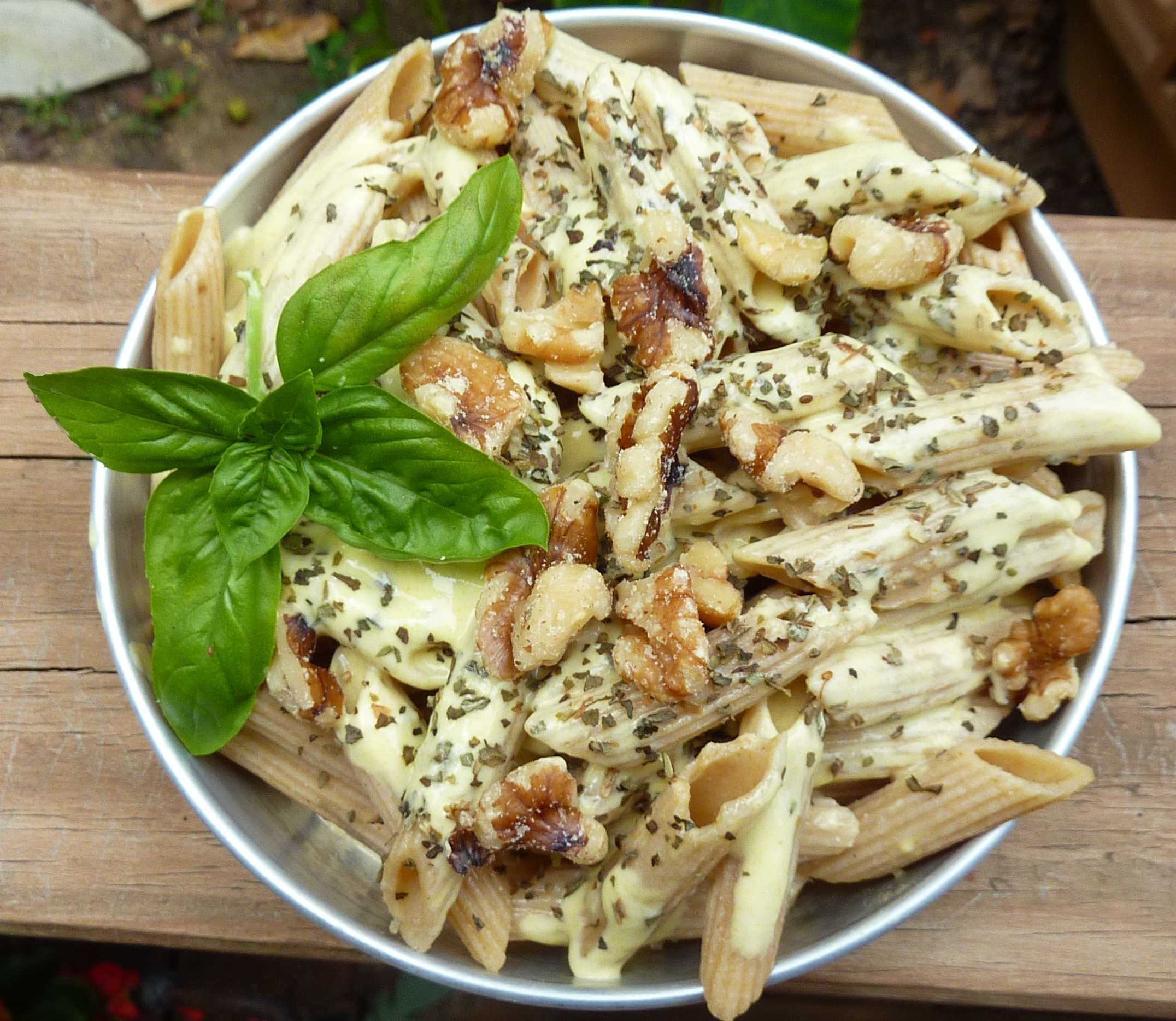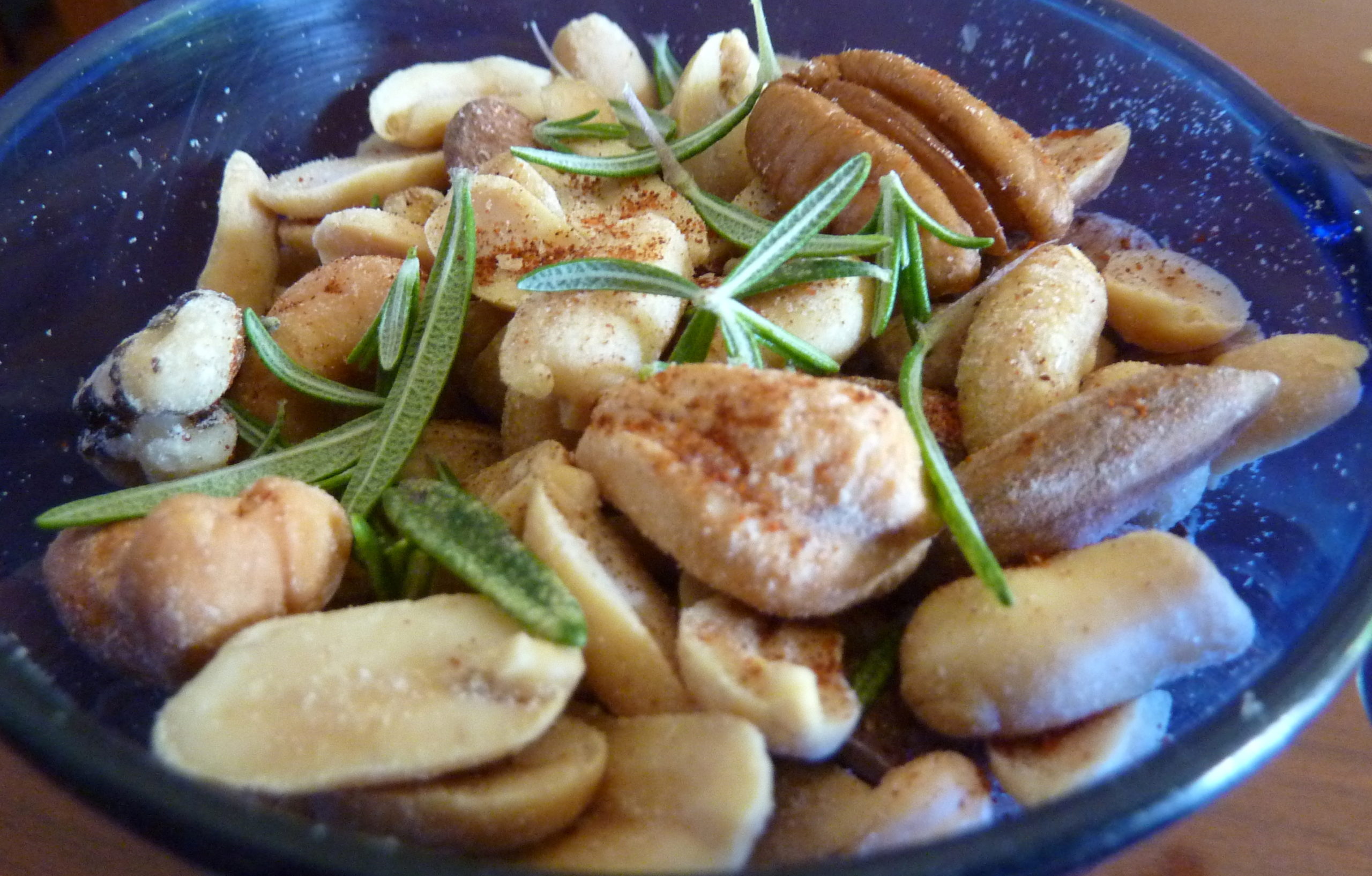
Nuts are an important source of food for backpackers. Nuts promote a healthy immune system by restoring nutrients and calories that are lost through backpacking and outdoor activity. Nuts also make a delicious snack food and add a crunchy texture to freeze-dried backpacking meals.
When it comes to caloric density, nuts are king. After pure fats and oils, nuts are the richest source of foods we eat, averaging 600 calories per 100 grams (3.5 oz, about 1 cup).
When trail food supplies are running low, nuts make the difference. Their high fat content takes the edge off hunger. Here we’ll briefly cover the nutritional value of nuts and give you our favorite mixed nut recipe – one that we like as a snack for home and trail.
Nutritional Value of Nuts
Nuts are incredibly rich in fat and protein calories. On average, nuts offer 50% or more fat from their oil and 10-25% in protein.
Nuts provide excellent nutrition for everyone and are especially important for vegetarians and athletes, who often need the added fat calories. Fueling the body with dietary fat from nuts & seeds is essential for maintaining energy needs during low-intensity endurance activities such as hiking or cycling, which require slower and longer durations. And because fat takes much longer to digest than proteins and carbohydrates, it is a good match for endurance activities.
Although nuts and seeds are high in fat, they are heart healthy fats (predominately monounsaturated fat), which help lower LDL (bad) cholesterol and raise HDL (good) cholesterol. Lower LDL lipid levels in the body protect against heart disease. Some nuts such as walnuts, and to a lesser extent, pecans, hazelnuts, and macadamias, contain plant omega-3 fats in the form of alpha-linolenic acid (ALA), which can help to reduce inflammation.
Besides supplying us with energy, fats help us function and feel our best by maintaining body warmth and keeping the joints lubricated. Fat also allows nutrients from foods (such as the lipid-soluble vitamins A, D, E, and K) to be absorbed in our small intestine.
From almonds to walnuts, tree nuts provide a distinctive range of flavor and nutrient composition. Vitamin E, an important antioxidant, is concentrated in most nuts, as well as calcium, folic acid, and arginine. Arginine is an important amino acid used to make the molecule nitric oxide. Nitric oxide relaxes constricted blood vessels and eases blood flow, thereby reducing the risk of blood clots. Arginine also triggers the body to make protein and helps heal wounds.
Because nuts are a plant food, they contain no cholesterol. All nuts – even legume peanuts – are healthful. Since each type of nut has such a unique nutritional profile, eating a variety is important.
An overview of the vitamins and minerals found in various nuts and seeds
- Almonds and sunflower seeds are high in vitamin E, an important antioxidant and immunity booster; note: most sunflower seed is imported from China; look for U.S. grown sunflower seeds, a native to North America;
- Brazil nuts are exceptionally rich in selenium (so much in fact, that you don’t want to eat more than two Brazil nuts per day); selenium is necessary for maintaining cellular health and the thyroid;
- Cashews, pecans, and sesame seeds are high in copper and manganese; copper helps with iron utilization, melanin production, and thyroid health; manganese keeps your bones strong and healthy;
- Chia seeds are good source of calcium and manganese; calcium maintains bones and helps clot blood;
- Pumpkin seeds are high in manganese, arginine, and magnesium; magnesium helps relax muscles and keep bones strong; note: like sunflower seeds, many are imported from China. Look for U.S. grown pumpkin seeds; the pumpkin is native to the U.S. and American growers need our support;
- Peanuts are a good source of niacin (vitamin B3), which is important for brain health and blood flow;
- Pistachios are an excellent source of vitamin B6, copper, and manganese; Vitamin B6 supports the nervous system and helps to digest sugars & starches;
- Walnuts are high in ALA Omega-3 fat, which is essential for cardiovascular health, reducing bodily inflammation, and lowering LDL triglycerides;
Nutrition of commonly consumed nuts & seeds

Incorporating nuts to your diet
Eat one to two handfuls of nuts daily (about 1 – 2 ounces) for the most benefit. Some other ways to incorporate nuts into your diet –
- Supplement meals with chopped nuts and seeds. Nuts improve the flavor and texture of muesli, granola, trail mix/gorp, hot oats, salads, sprouts, desserts, vegetable, rice and pasta dishes.
- Thicken meals with nut butter. Nut Butter is made by blending the creamy inner flesh of nuts. Nut butter is delicious on a tortilla, and adds creamy flavor when mixed in with pasta and hot cereal. We like almond butter, peanut butter, and tahini. Nut butter packets and dried peanut butter are convenient for the trail.
- Nut Milk can be made at home by soaking nuts in water (almonds work well) and blending the soaked nuts with added water. Strain off the fiber, if desired.
- Nut Flours, useful in gluten-free cooking, is made using the dried leftover solids of nut milk and nut oil manufacturing. Use it to thicken and fatten up cereals, rice and pasta dishes.
- Nut Mix. Nuts are good as is, or when mixed with other nuts, dried fruits, and candies. Make a large batch of trail nut mix in advance so it is available. Here is one of our favorite mixed nut recipes.
Mixed Trail Nut Recipe
Winter is a good time to perfect your trail snack making skills before you hit the trails full force in the spring. These mixed nuts are also a satisfying treat at home with a side of beer!

Ingredients
2.5 cups of assorted unsalted nuts (a good mix is ½ cup peanuts, ½ cup cashews, ½ cup walnuts, ½ cup almonds, ½ cup pecans, a few brazil nuts)
2 TB fresh rosemary, coarsely chopped
1/2 tsp cayenne pepper
2 TB unprocessed cane sugar (such as sucanat, muscovado, turbinado; or brown sugar)
1 TB maple syrup or brown rice syrup
1.5 tsp sea salt (eliminate or reduce if using salted nuts)
2 TB of coconut oil, olive oil or Earth Balance (we prefer coconut oil)
Cooking Directions
Line a baking sheet with parchment paper. Spread nuts onto the baking sheet and toast for about 10-12 minutes. Remove nuts and let cool for about five mins. While cooling, mix the sauce ingredients (rosemary, cayenne, cane sugar, maple syrup, sea salt, and oil). Add sauce to nuts and mix well. Pour nuts back on the baking sheet and bake for another 10-12 minutes until golden. Cool for about 20 minutes and serve warm. Makes 2 1/2 cups. Store in a closed container.
Recipe adapted from Twice Baked Bar Nuts from the website ohsheglows.com
Unless you have a nut allergy, we highly recommend adding nuts to your daily diet and eating them on the trail. Nuts are one of nature’s most nutritious and delicious foods — from reducing hunger pangs and heart attacks, to lubricating joints, to garnishing backpacking food, to replacing lost calories and nutrients, they offer a multitude of benefits to help us stay strong and healthy. Nuts are truly a gift from nature.
